I spent two years walking to every cathedral in England – and made some incredible discoveries
Over the course of two years, the Earl of Selborne undertook to walk to every cathedral in England, and found himself inspired by stunning architecture, amazing music, beautiful countryside – and the occasional canalside pub
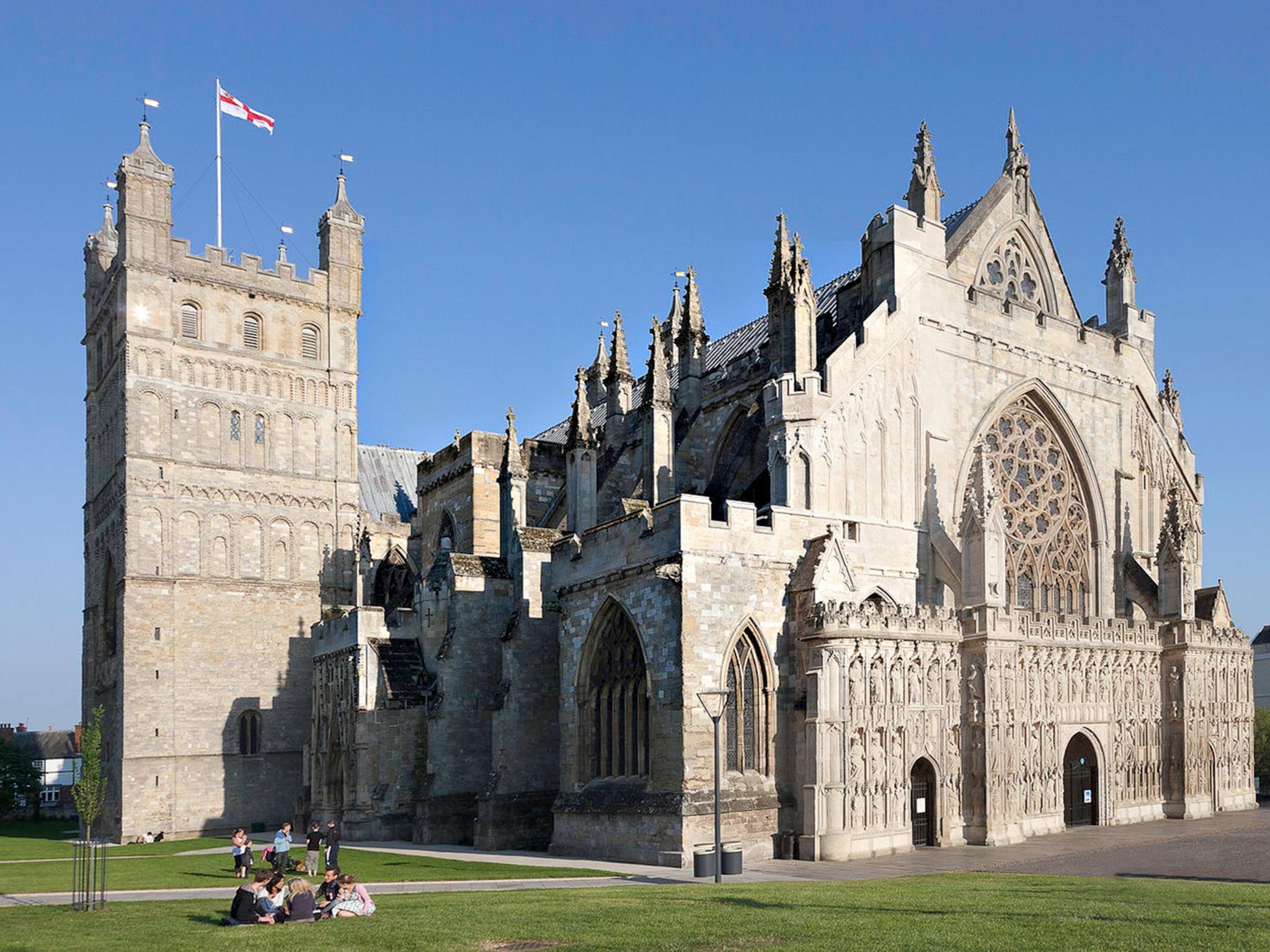
Your support helps us to tell the story
From reproductive rights to climate change to Big Tech, The Independent is on the ground when the story is developing. Whether it's investigating the financials of Elon Musk's pro-Trump PAC or producing our latest documentary, 'The A Word', which shines a light on the American women fighting for reproductive rights, we know how important it is to parse out the facts from the messaging.
At such a critical moment in US history, we need reporters on the ground. Your donation allows us to keep sending journalists to speak to both sides of the story.
The Independent is trusted by Americans across the entire political spectrum. And unlike many other quality news outlets, we choose not to lock Americans out of our reporting and analysis with paywalls. We believe quality journalism should be available to everyone, paid for by those who can afford it.
Your support makes all the difference.This month, on Easter Day, I completed a series of linked walks which have taken me two years. I went from my home in Hampshire to every Anglican cathedral in England. The last was Exeter, having come from Truro Cathedral and met up with my earlier route from Wells.
When I started on this long distance obsession I had no thought of visiting every cathedral.
Instructed by my oncologist after chemotherapy and radiotherapy to take plenty of exercise, I took part in two sponsored walks, one of which was a one day hike along part of the North Downs Way in Surrey. My wife and I were at least 30 years older than most other participants and the challenging pace left little time to admire the stunning views or the rare orchids.
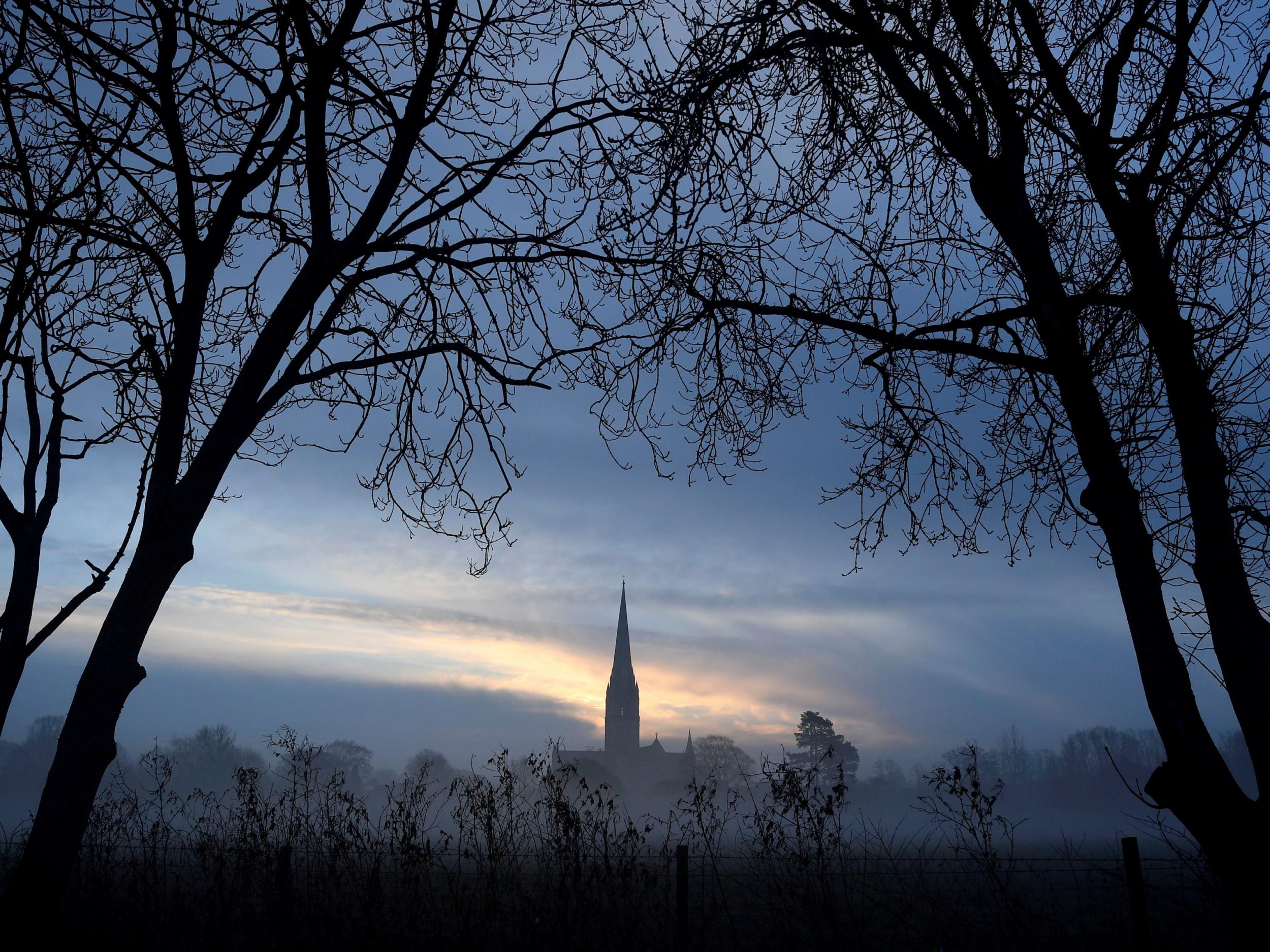
I resolved to go at my own pace along more of the North Downs Way, allowing myself time to enjoy the truly impressive landscape. I soon noticed that The Pilgrims Way from Farnham to Canterbury follows much of the same route. As I passed milestones recording the distance to Canterbury I found myself resolving to complete the extended pilgrims’ journey from Salisbury to Canterbury. Perhaps the fact that my family name, Palmer, means “a pilgrim” had some subliminal influence.
I broke off my progress along the North Downs Way to walk to Portsmouth and Chichester Cathedrals. I know Chichester Cathedral well and have a great affection for the medieval enclave, which includes the bishop’s palace, cloisters, almshouses, and the cathedral itself. I particularly admire the Piper tapestry and the window by Marc Chagall. Both of these wonders were installed in the second half of the 20th century, demonstrating that a cathedral, however venerable, can remain vibrant with new treasures and be relevant to successive generations.
After arriving at Chichester in November 2016, I was firmly resolved to get to as many cathedrals as I could manage by the end of April 2017. That would mark the anniversary of my first sponsored walk on behalf of Gilbert White’s House, from Abingdon to the parish of Selborne, where I live.
My wife Joanna and I were married in Christ Church Cathedral, Oxford, another cathedral with very happy memories. The walk from Christ Church to Abingdon was simple, along the Thames early on a December morning when college rowing crews were already training and herons were competing for river space.
Over the New Year Joanna and I hiked from Salisbury Cathedral to Winchester Cathedral and arrived in time for Choral Evensong. I now appreciated just how peace-inducing this service could be after a strenuous two days through hilly countryside and fine views.
Evensong starts with the choir chanting a psalm, followed by the exuberant rendering of the ‘Magnificat’, the song of Mary rejoicing at the prospect of the birth of her child Jesus. Then, in a marked contrast, the choir sings the New Testament’s ‘Nunc Dimitis’, the song of an old man reconciled to death now his life has been fulfilled. An anthem follows and finally a hymn.
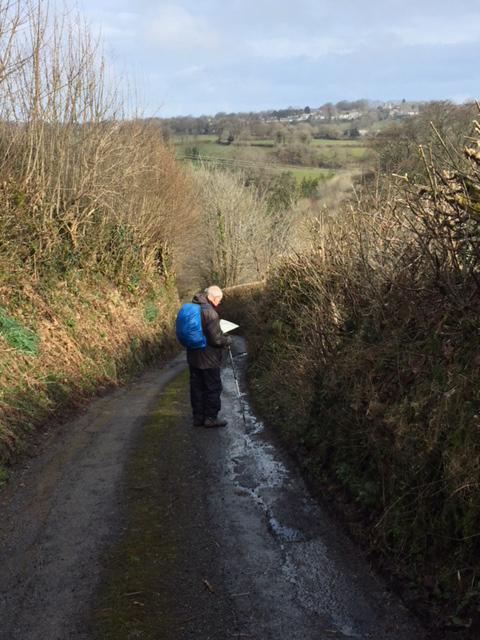
I am not surprised that cathedral choral evensong services attract ever more attendees each year. The quality of the music in so many of our cathedrals is as remarkable as the stunning medieval architecture. As I arrived at ever more spectacular cathedrals over the following months I came to be touched with the same enthusiasm as those early pilgrims.
I next went from Compton on the North Downs Way to Guildford Cathedral and along the Wey Navigation to the River Thames. I had no idea that this canal was the first in England, built either side of the Civil War. The day was memorable for kingfishers, parakeets and an excellent pub.
Following the Thames Pathway into central London, I was able to visit both St Paul’s and Southwark cathedrals. Although this was a crowded route compared to my usual footpaths it was something of a revelation to see London as a weekend pedestrian and not as a harassed, mid-week driver.
On most of my walking days I covered about 15 miles, usually along footpaths and bridleways, but an exception in two respects was the walk from Westminster to St Albans Cathedral. For one thing, the route covered 20 miles; for another, most of the way was along the multicultural Edgeware Road. Only when I got to leafy Hertfordshire did I find a footpath.
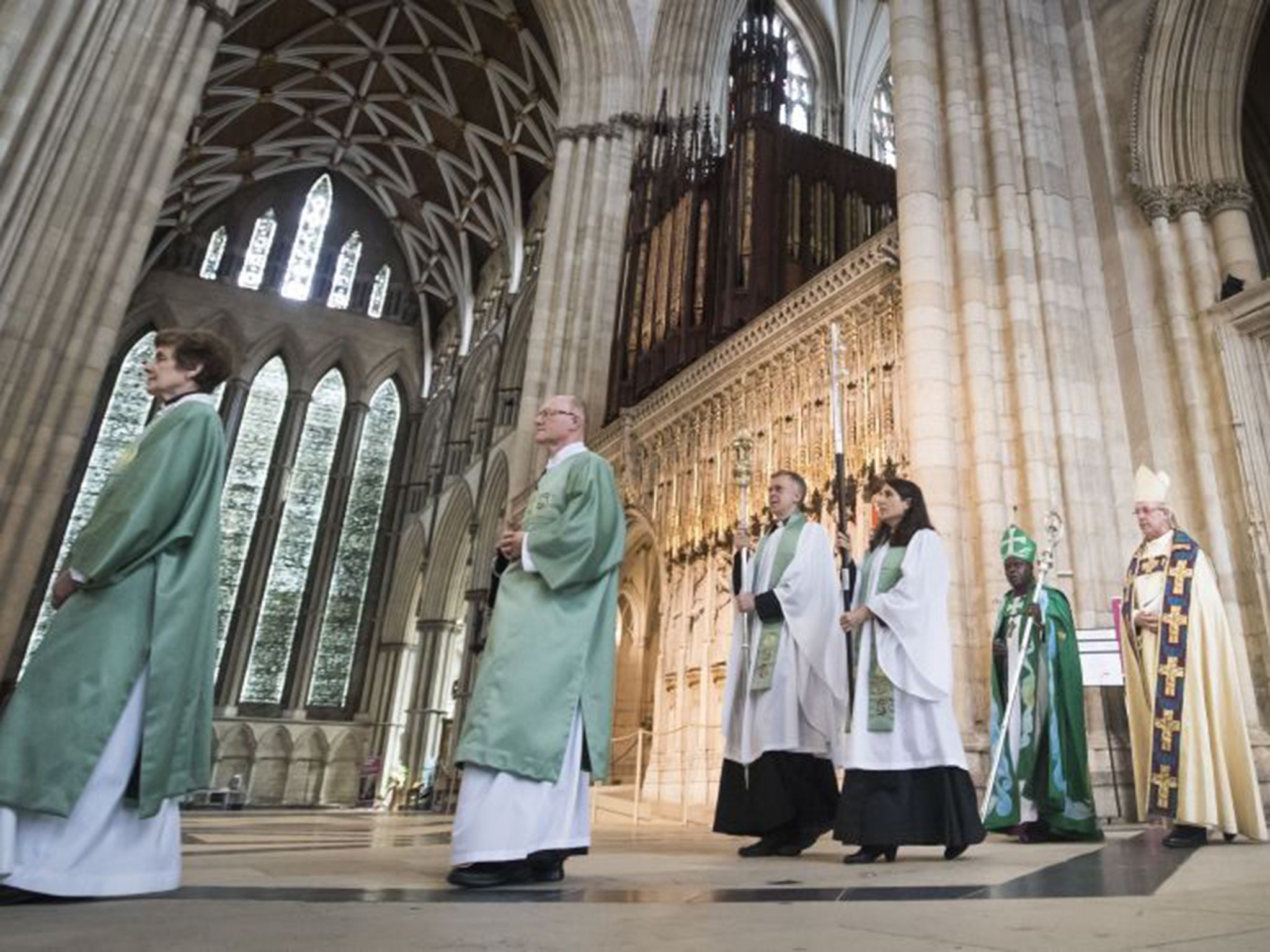
When the great political radical William Cobbett (1763 to 1835) undertook his rural rides, he fell in with fellow travellers with whom he would discuss the burning issues of the day. Passing the Aston Martin factory on my way from Oxford to Coventry I felt I had a rare opportunity to do the same as I met an apprentice making his way back to his lodgings after his shift.
I asked about the implications of Brexit for his business and heard how the management had shared with the workforce their plans for this contingency. He seemed confident that a world class product would continue to prosper. Some months later near Newcastle, when I unwisely let slip that I was a member of the House of Lords, a local Brexit enthusiast told me in no uncertain terms what he would do to Their Lordships if they delayed our withdrawal from the European Union.
During my pilgrimage I came to appreciate the merits of towpaths. They are flat; usually the only nearby traffic is on the water; and conveniently sited, canalside pubs are plentiful.
Between Banbury and Heyford, a Muntjac deer on the opposite bank took a flying leap into the middle of the Oxford Canal, swam to my side and then ran past me into a wood. On the walk along the Lichfield Canal into Birmingham we saw remarkable examples of derelict warehouses, now liberally adorned with graffiti and no doubt soon to be converted into desirable housing. Between Lichfield and Derby my brother and I met up with a narrow boat owner who dispensed some very welcome refreshment. Meanwhile, I found that the view of Worcester Cathedral was rather better from the path running alongside the Worcester & Birmingham canal than from the streets inside the city.
In April 2017 I completed the Pilgrims Way walk from Rochester to Canterbury; with some of my family joining me for what I assumed would be the final walk and an inspiring Choral Evensong.
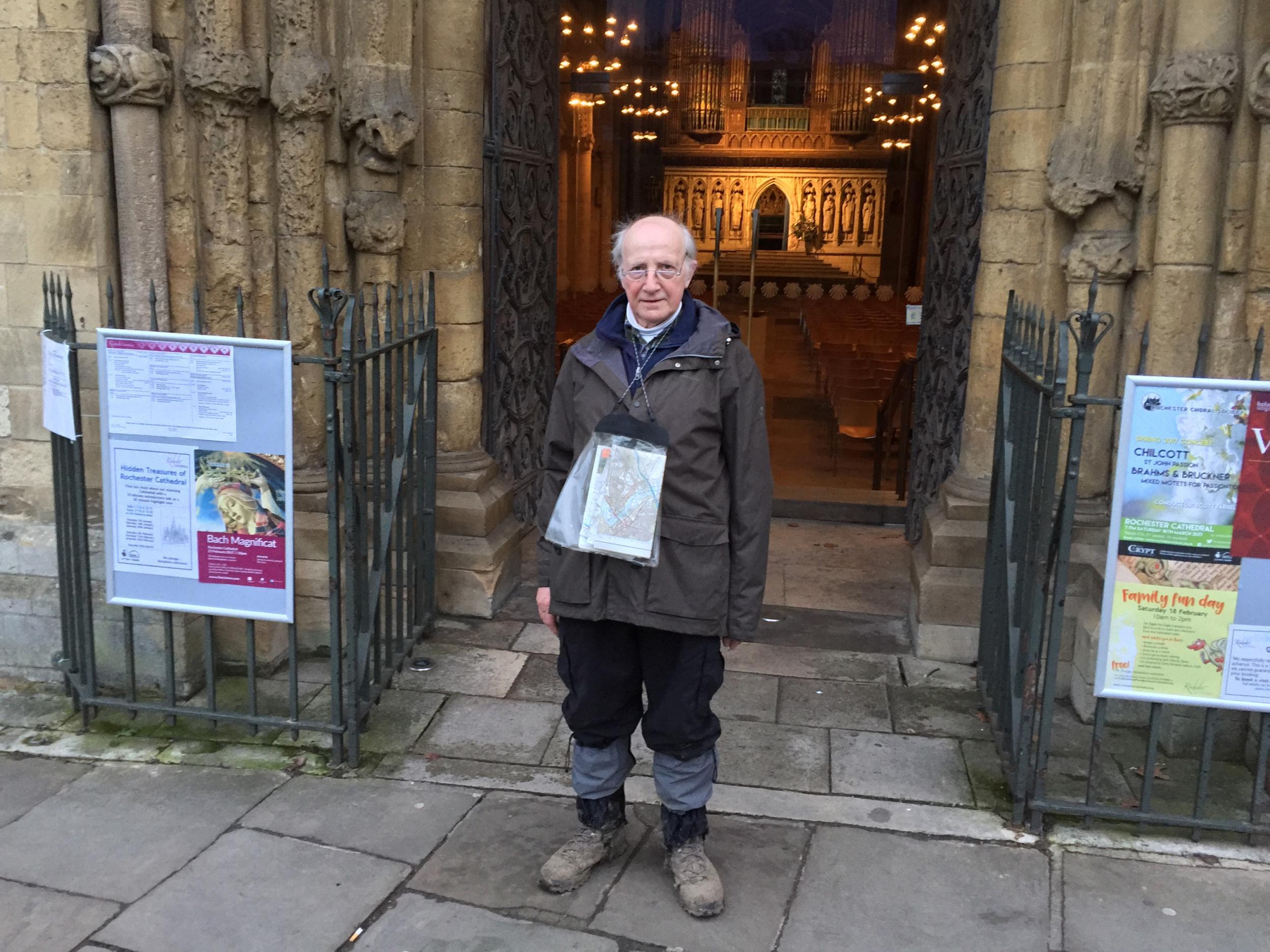
It was not to be. Joanna and my son George opened an appeal for sponsorship to celebrate my achievement of linking my parish church to 18 cathedrals. They raised so much money that I felt honour bound to walk to the remaining 24.
Some of the subsequent routes were little frequented by hikers. Much as I admire both Ely and Peterborough cathedrals, the pedestrian has no choice for much of the way but to follow narrow Fen roads with no pavement. Heavy lorries thunder along them.
Once, I found a dyke with a bank I could walk atop and I noticed that a cuckoo was flying from telegraph pole to telegraph pole ahead of me, loudly calling for a mate in an area of intense vegetable production and little cover. Cobbett, who was all for agricultural modernisation (provided it helped the labourer), would have been impressed by the technically advanced harvesting systems for iceberg lettuce with a large gang of seasonal workers operating the sophisticated rigs.
I had not included abbeys in my list of objectives, although Simon Jenkins allows an entry for Westminster Abbey in his book England’s Cathedrals. On the way from Worcester to Gloucester, Joanna and I stayed the night in a hotel with a fine view of Tewkesbury Abbey and next day passed the site of The Battle of Tewkesbury, the final battle of the War of the Roses.
Our walk from Salisbury to Wells gave us perhaps the most magnificent panoramas. In every direction from the high ridges were superb views of the downland landscape, with hardly a house to be seen. It is only when walking along obscure footpaths that it becomes apparent that the south of England still includes some very large tracts of open land.
Wells to Bristol was more of a challenge as we climbed the Mendips; but again the effort was more than compensated by the vistas.
Some of the West Country bridleways were evidently of great antiquity. Never metalled but sunken through long use by wagons, their hedges must have first been laid centuries ago. I am no expert on mosses, sedges and ferns but, if I were to choose for my next obsession a study of these plants, I would start in the sunken lanes of Cornwall, Devon, and Somerset. Near Hereford we found astonishingly ancient cider orchards too.
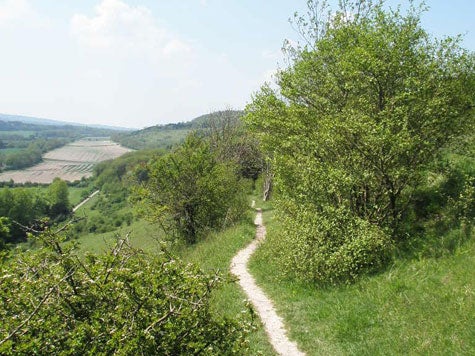
At Southwell Minster I admired the statue of the first bishop, The Rev George Ridding. He found Southwell a little too provincial and preferred to live in Nottingham. I was told that throughout his tenure of office from 1884 to 1904 he never once spent a night away from his bed, so his coachman was required to drive him heroic distances from the far parts of his diocese to his home.
The approach to Lincoln, like Canterbury, Ely and Durham, gives encouragement to the advancing pilgrim because of the distance from which one can see the cathedral. The final climb, however, up the steep hill in the centre of Lincoln is hard work after so many miles on the flat.
I walked to the cathedrals of Manchester, Liverpool, Bradford and Chester on my own. There was more walking on main roads than I would have wished, though from Manchester towards Liverpool and Chester I was able to follow canals, including the Ship Canal, for some of the way. The large chemical works along the Mersey stand out on the horizon higher than any cathedral.
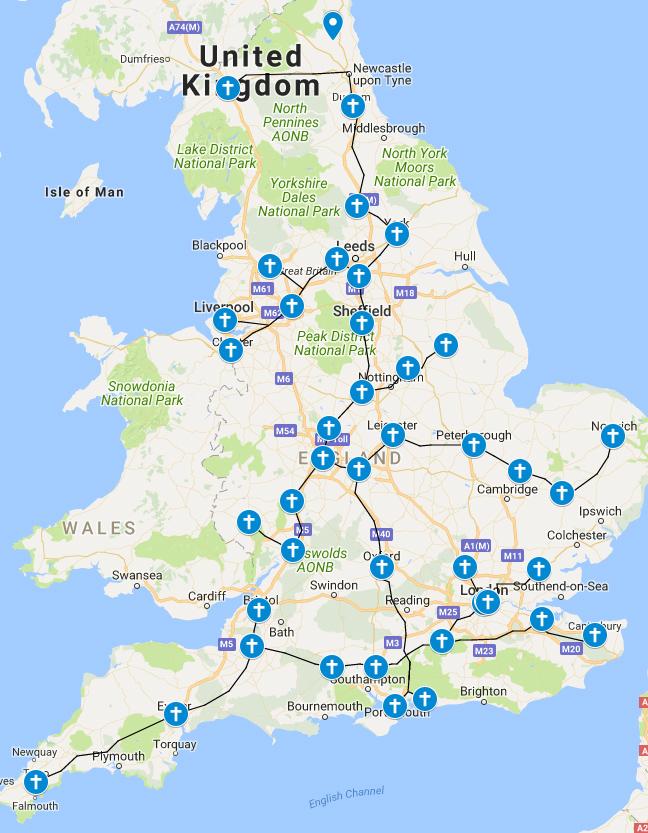
The longest climb of my entire two years was over the Pennines between Halifax and Rochdale. When I came back to complete the walk to Blackburn with Joanna I resolved to start at Rochdale so that we could visit the magnificent Rochdale Town Hall.
It was becoming evident that I had left some of the outliers to the end. Durham was a long way from Ripon; as was Carlisle from Newcastle. Joanna and I found our way across the River Tees barred by a gate with spikes, yet the bridge itself was clearly marked as a footpath. As we managed to negotiate this obstacle with what I considered to be commendable agility for septuagenarians, I reflected that the last time I had negotiated such a hazard was climbing into my college at Oxford as an undergraduate.
The approach to Durham along the River Wear will remain one of my abiding memories. I have admired the cathedral on countless occasions from the railway but the glimpse is all too brief. The only sensible way to approach Durham is by foot along the river.
The giant pillars in the cathedral nave have incised patterns which originally would have been coloured. How remarkable this must have appeared to early visitors back in the 12th century. Other mediaeval cathedrals were equally decorated in their time with bright paints. Will anyone have the courage to restore the original colours?
My final walks were to take me from Wells to Exeter, then Truro to Exeter. Cornwall and Devon are beautiful counties, with their challenging hills and patchworks of small fields enclosed by ancient, well maintained hedges.
Accompanied by 17 members of my family (and two dogs) I arrived, as planned, at Exeter Cathedral on Easter Day just in time for Processional Choral Evensong. The anthem was Handel’s Hallelujah Chorus. Hallelujah indeed!
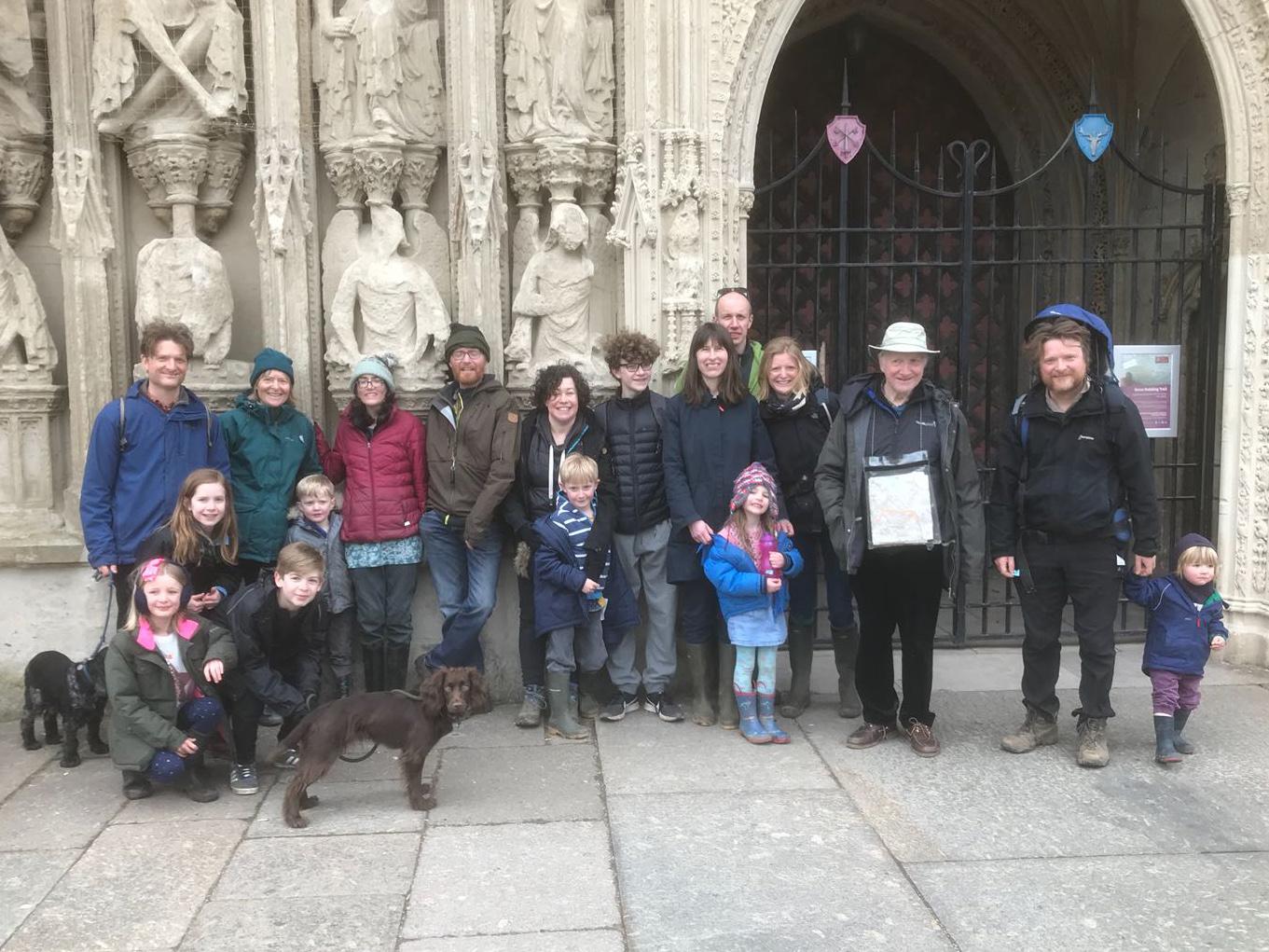
John Roundell Palmer, 4th Earl of Selborne, GBE, DL, FRS is a British peer, conservationist and businessman. He is accepting sponsorship on a final walk to support bursaries at King Edward’s school, Witley
Join our commenting forum
Join thought-provoking conversations, follow other Independent readers and see their replies
Comments